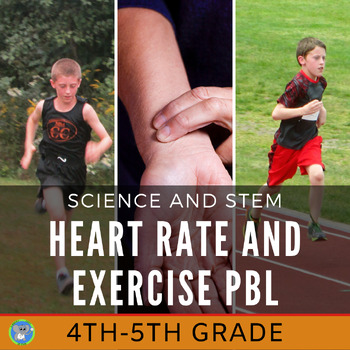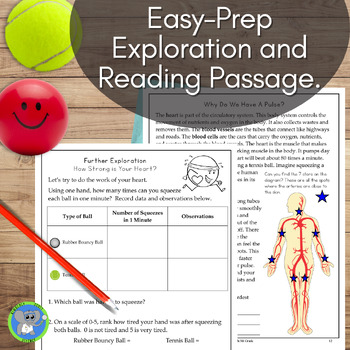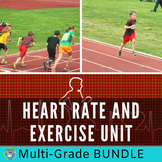Valentine's Day Science and STEM | Heart and Exercise Activities | Grade 4 5
- PDF
- Easel Activity
Also included in
- Bundle and SAVE on this collection of our favorite science and STEM holiday activities. You will get 7 project-based units that are popular for Halloween, Thanksgiving, Christmas, Valentine's, Saint Patrick's Day, and Easter. They meet the standards and can be used anytime, too!Each Unit IncludesAnPrice $32.92Original Price $41.15Save $8.23
- Explore the role of the heart and cardiovascular system with a complete K-5 Science and STEM easy prep unit. Great for a full month of February fun! Students will investigate if exercise affects their heart rate using grade-level-specific journals following the scientific method. Also includes a StePrice $16.84Original Price $21.05Save $4.21
- Bundle, Save, and Meet the Standards. Discover 8 hands-on investigation units plus over 30 demonstrations. These lab activities guide students to discovery. Save yourself time searching for lessons. Explore weather, chemistry, plants, health, the properties of matter, and more. Memorable labs thatPrice $37.64Original Price $47.05Save $9.41
- Integrate a complete science unit into your F2F or virtual classroom. Students will complete an easy PREP heart rate lab and extend their learning to discover the relationship between respiration and circulation in exercise. Everything is set to go with TpT digital and Google Slides. Bundle and SPrice $8.92Original Price $11.15Save $2.23
Description
Discover the role of your cardiovascular system with an engaging Science and STEM exercise study for February or any time of the year. Includes an easy-prep experiment, heart strength lesson, and stethoscope design challenge. A comprehensive teacher guide and student reading passage are included to make it a complete project-based learning activity.
*Newly updated on January 29th, 2024!!!! Now includes 3 activities.*
Included in the Hands-On Investigation:
- NGSS Alignment 4th and 5th Grade
4th and 5th Grade Science and Engineering Practices
4th Grade Structure, Function, and Information Processing
- Teacher Background Information and Tips
- Investigating the Effects of Exercise on Heart Rate Science Journal (Easy Prep)
- Further Exploration: How Strong is Your Heart? (Easy Prep)
- Reading Passage: Why Do We Have a Pulse?
- Stethoscope STEM Challenge Engineering Design Journal
- Rubric and Answer Keys
- Prepared Easel by TPT Template for display or student use.
Students will
- follow the scientific method and think like a scientist.
- learn how to take their pulse and calculate the beats per minute.
- identify the independent variable, dependent variable, constants, and control.
- calculate the mean, graph, and summarize their results.
- compare two different models to show the heart's strength.
- discover new vocabulary: pulse, blood vessels, arteries, and more.
- learn from their failures and successes in creating a working stethoscope.
Teachers will like its’ ease of use, simple materials, background information, and thoroughness. This is our most easy prep investigation. Many teachers use this lab as a back-to-school activity to introduce the scientific method or as a Valentine-themed science exploration. The added exploration and STEM activity make this a complete unit.
We estimate 2-4 weeks if you complete everything. Each activity can be completed on its own but is most complete if done together.
Supplies Needed
Student, Chair, Stopwatch, or Secondhand, tennis balls, rubber bouncy balls, and typical STEM supplies like straws, cups, and paper tubes. You may want to provide tubing. That's it!
This investigation is part of a series. This is the 4th/5th-grade version. Please click each grade level version below to see more details. We hope your students have a wonderful experience discovering the role of their heart.
Heart Rate And Exercise Activities | Grade K 1 | February Science And STEM
February Science and STEM | Heart and Exercise Activities | Grade 2 3
Save 20% with the BUNDLE
The Effects Of Exercise On Heart Rate: K-5th Grade Experiment Bundle
Great for human body units, health and wellness, PE, a class science fair project, and a Valentine-themed Exploration
You might also like
Science Reading Comprehension | Respiration And Circulation | Human Body Unit
Valentine Candy Heart Erosion Lab | Earth Science Experiment
Forces and Motion Unit | Grade 4 And 5 Newton's Cradle Science And STEM
Remember, leaving feedback earns you points toward FREE TPT purchases. We love hearing how the investigation went.
Also, follow us and be notified when new explorations are uploaded and deals.
Please contact us with any questions! We are here to help.
Yours in Science,
Kimberly Scott
All parts are copyrighted. Please see the Terms of Use in the download.










